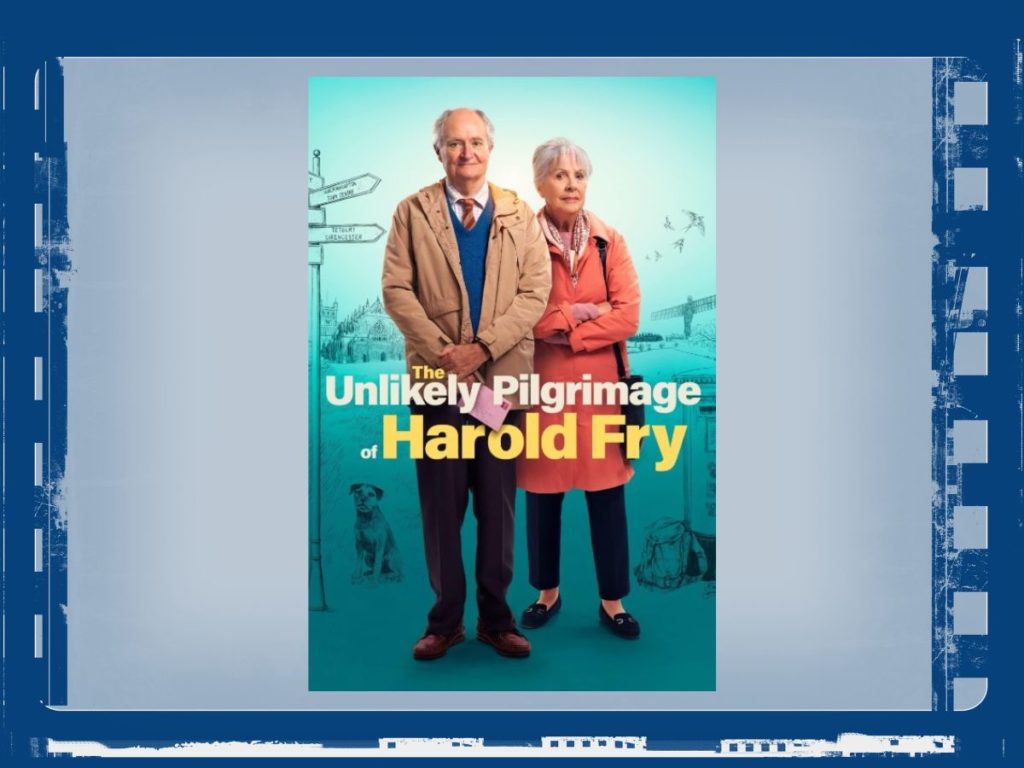Film Review: The Unlikely Pilgrimage of Harold Fry


The Unlikely Pilgrimage of Harold Fry
Directed by Hettie Macdonald
Ingenious Media and Embankment Films, 2023
Run time: 1 hour 48 minutes
Reviewed by Amy Horton | Warrenton, MO
The Unlikely Pilgrimage of Harold Fry is a British drama film based on Rachel Joyce’s novel of the same name. I read the book years ago and looked forward to its film release. I recently saw a social media post from a pilgrim friend, Anne, reporting that the movie is now available for streaming in the United States. In her post, Anne described the film as “the best depiction of a true pilgrimage that I’ve seen.”
The film begins when the titular character, a retired pensioner living with his wife in Devon in southwest England, receives a letter from his friend, Queenie. She informs Harold she’s dying of cancer and has entered hospice care in Berwick-upon-Tweed, in northeast England. Unsatisfied with the perfunctory, inadequate response he writes to Queenie, Harold sets off to drop it in the mail anyway. He hesitates to post the letter at every opportunity—at a post box near his home, at another box in town, with a letter carrier on the street, and at the post office. Soon, he’s inspired to walk to Queenie instead—as long as he keeps walking, she’ll keep living, Harold believes. He adds a message to the back of the envelope letting Queenie know he’s on his way, posts the letter, and then sets off on his unlikely journey of nearly 500 miles.
I concur with Anne’s assessment: this story is a genuine portrayal of pilgrimage. Harold feels compelled to make a long journey to a specific place. He embarks with minimal possessions. He experiences his days with a mindfulness he hadn’t before. He utters a mantra, “You will not die,”—perhaps speaking to Queenie, though maybe also encouraging himself. He has moments of self-doubt that bring him to the edge of quitting. He opens himself to hospitality—receiving it from strangers and offering it to others. He’s joined along the way by others and must discern when to separate from his fellow travelers to progress on his way. We also observe the simultaneous journey of Harold’s wife, who feels left behind and struggles to understand where she fits into her husband’s new pilgrim life.
Early on, a farm wife meets Harold’s request for a glass of water and offers him a spot to sit and rest a bit. As they talk, he admits he is walking a long way but hasn’t quite gotten the hang of it. She wisely observes, “You’d have thought walking would be the simplest thing. It never ceases to amaze me how difficult the things that are supposed to be instinctive really are. Eating. Sleeping. Keeping children.” Here, we learn Harold had a son. And from here—as we observe Harold’s outer journey through the bucolic English countryside, along some busy roadways, and into the bustle of the occasional city—in flashbacks we also get glimpses into Harold’s difficult inner journey.
For the sake of space and no spoilers, I won’t tell you who Queenie is to Harold and whether he reaches her. Watch the film to learn that. What I will tell you is this: true to the nature of pilgrimage, as Harold walks toward Queenie, we discover this journey of hope, forgiveness, and love is about so much more than reaching her.
Got a book or film to review? Let La Concha know!
Have you published a Camino- or pilgrimage-related book that La Concha has not yet reviewed? Did you produce a film on the subject that you want fellow pilgrims to know about? Drop an email to laconcha@americanpilgrims.org with the title and a brief synopsis of your creative work, and we will connect you with one of our reviewers for consideration.


